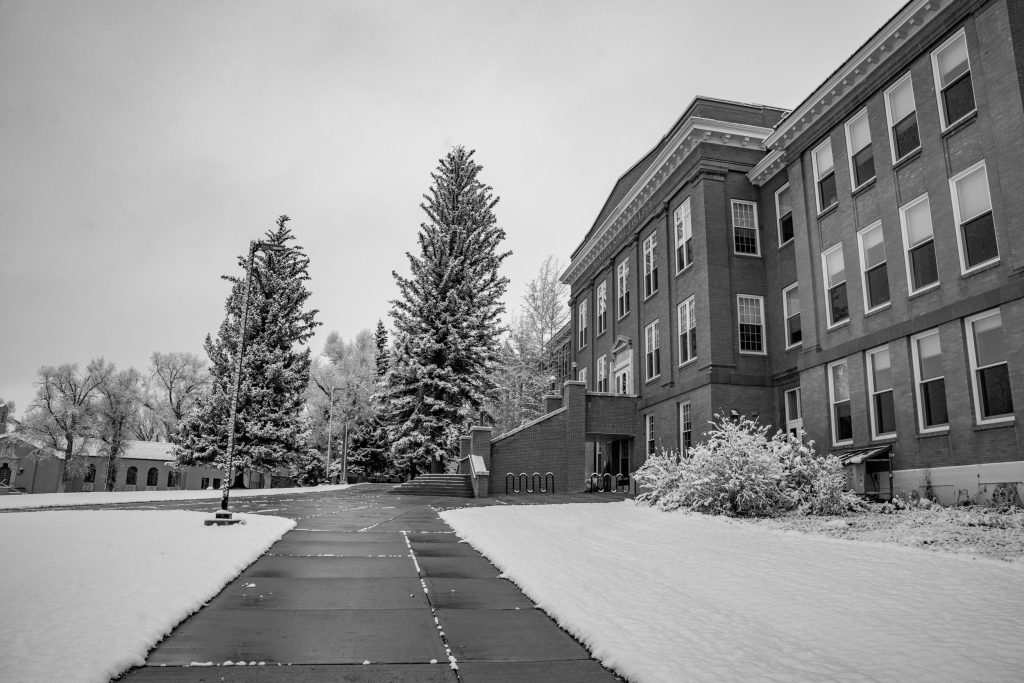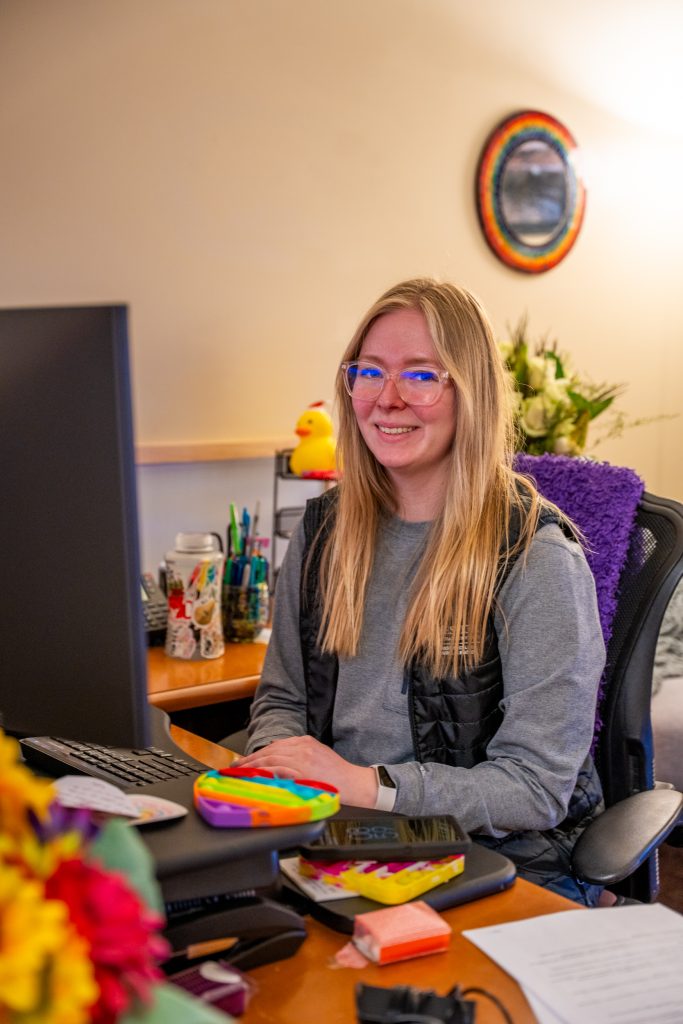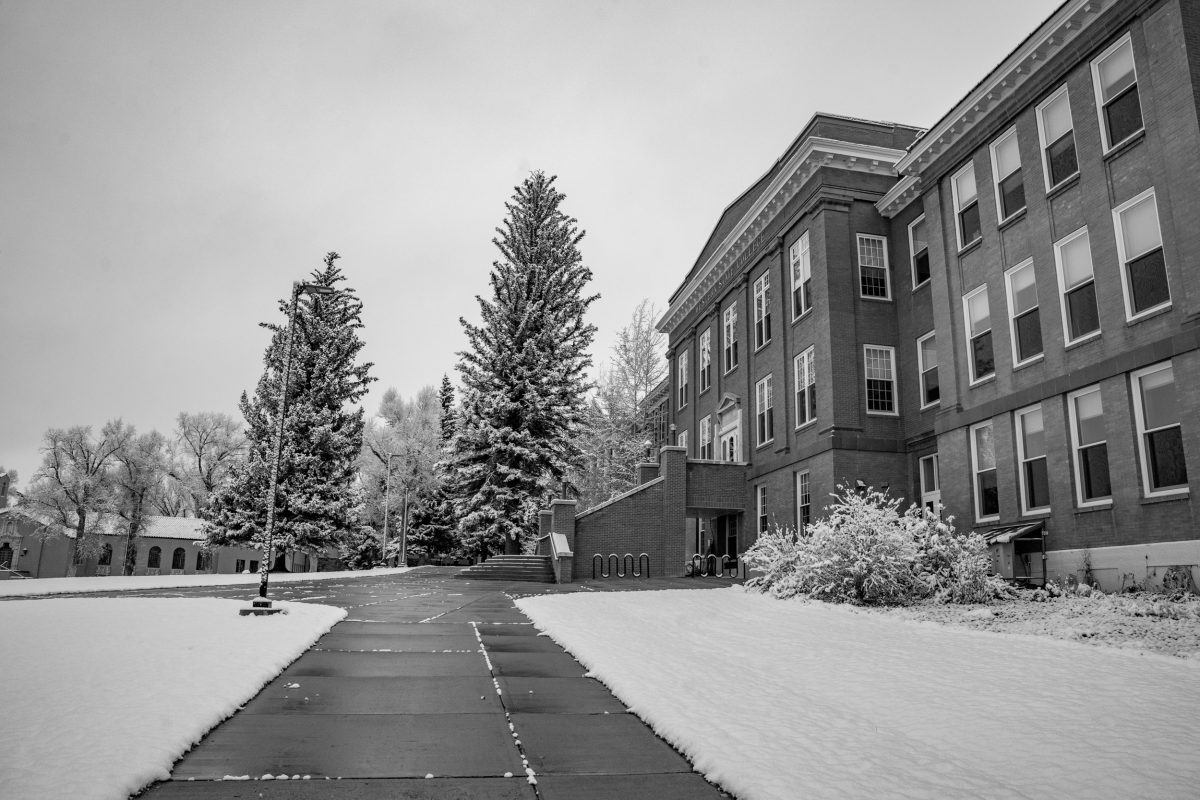
By Katie Henderson
Rural Gunnison County Faces Mental Health Crisis with High Suicide Rates
By Katie Henderson

McKenzie Mathewson is sitting at her desk in her office.
Photo by Katie Henderson
Gunnison County, CO – At a corner table, McKenzie Mathewson sat at her desk as she observed students trickle in and out of the University Center on Western Colorado University’s campus. Mackenzie, the Associate Director of Community Wellness, had spent countless afternoons here in her office, often meeting students who needed support but didn’t know where to begin.
“Mental health is so multifaceted. It’s hard to pinpoint one thing as the problem, but small, rural mountain towns like Gunnison do face unique challenges,” said McKenzie
Tucked into the heart of Colorado’s rugged mountains, Gunnison County offers breathtaking landscapes and unparalleled outdoor adventures. But beneath the idyllic setting lies a stark reality: a growing mental health crisis marked by suicide rates nearly double the state average.
Gunnison County’s suicide rate has reached a staggering 39.5 deaths per 100,000 people; the state average is 20.2. This troubling statistic reflects a growing crisis, with 2023 marking a sharp increase in reported suicides. As of midyear last year, reflecting most recent available data, the county had already surpassed the total number of suicides reported for all of 2022, an alarming upward trend. “This number was more than five times the national average,” said Meghan Dougherty, Executive Director of CB State of Mind, a mental health advocacy organization in Crested Butte.
According to CB State of Mind, this grim statistic reflects deeper, systemic issues affecting the mental health of every corner of the community, from rural residents to students at Western Colorado University.
Unique Challenges in the Valley

Living in a remote, rural area like Gunnison County amplifies mental health struggles. The isolation of long winters, the instability of seasonal employment, and rising living costs take a heavy toll. “Living here is incredible, but the pressure to keep up with high living costs and the hustle of seasonal jobs can be overwhelming,” said Dougherty.
Youth are particularly vulnerable in this crisis. According to the Gunnison Watershed School District, 20% of high school students seriously considered suicide last year. Alarmingly, this figure climbs to 52% among LGBTQ+ students, who face additional societal pressures.
“People feel like they have to tough it out, and that’s a dangerous mindset,” Dougherty explained. “In this community, self-reliance is valued so highly that asking for help can feel like admitting weakness. That stigma isolates people even more.”
Across Gunnison County, residents face numerous barriers to accessing mental health care. Roughly 9% of residents—about 1,480 people—report being unable to secure the care they need. Cost, insurance coverage, and long wait times for appointments often deter individuals from seeking treatment.
Mental Health and Suicide at Western Colorado University

Photo by Katie Henderson
Western, located in the heart of Gunnison, faces its unique mental health challenges. While the university offers incredible opportunities for outdoor recreation, its students are not immune to the broader mental health crisis affecting the county. In recent years, the campus has grappled with the devastating impact of suicide, including the loss of at least one student and faculty member just last year. The demand for mental health services at Western has grown substantially, with students facing stress related to academics, personal life, and the isolation of living in a rural town.
McKenzie Mathewson explained that many students at the university struggle to secure appointments with mental health professionals. “We have more students reaching out for help than therapists available to see them,” Mathewson said. This imbalance is compounded by a general reluctance among students to ask for help, a common cultural barrier in rural areas.
“The stigma surrounding mental health can be a big barrier for students,” Mathewson said. “We see students who wait until they’re in crisis before reaching out because they don’t want to admit they’re struggling and view mental health as a taboo subject. That delay makes it harder to intervene. So, when they hit a point where they need help, it’s a huge barrier to overcome.”
The impact of suicide on campus has been deeply felt. A friend of a Western student who recently died by suicide shared their perspective anonymously: “He was always the person who could make everyone laugh. None of us knew how much he was struggling. It’s been so hard, but it’s also opened our eyes to how important it is to check in on each other.”
The isolation that many students feel, combined with the pressures of school, contributes to feelings of stress and, in some cases, suicidal thoughts. “Living in a small town can feel isolating for students, even though they have access to great outdoor spaces and opportunities. When you’re struggling, the small-town nature of Gunnison can feel like a pressure cooker,” Mathewson added.
To combat this, Western is implementing several initiatives aimed at improving mental health awareness and support. The Green Bandana Project is a peer support program that aims to encourage students to wear green bandanas as a symbol of mental health awareness. Those who wear the bandanas are trained to provide support, reduce stigma, and connect their peers with resources.
Also, one Western student, Bridget Feely, is using her platform as a student-athlete to tackle an often-overlooked issue: mental health challenges among student-athletes. Inspired by NFL running back and Western alumnus Austin Ekeler’s Eksperience app, which connects fans with athletes for a fee, Feely saw an opportunity to raise awareness and funds for this critical cause. As a Campus Captain for The Hidden Opponent (THO), a nonprofit addressing mental health stigma in sports, Feely aims to use the app to spotlight the organization’s mission. “Suicide is the second leading cause of death in this population,” Feely said. “My goal is to promote The Hidden Opponent and guide users on how they can help.”
Community Response Provides Hope
Organizations across Gunnison County are stepping up to address the mental health crisis. CB State of Mind provides free and low-cost counseling, mental health first aid training, and community workshops, working tirelessly to reduce the stigma around mental health and fill critical gaps in care.
“CB State of Mind was founded to normalize conversations about mental health and ensure anyone who needs help can find it. We want to meet people where they are,” said Executive Director Dougherty.
At WCU, events like Wellness Fest connect students to free counseling and life skills workshops. “We want students to know help is available and that they’re not alone,” said McKenzie.
Advocates like Dougherty and Mathewson call for increased funding, affordable housing, targeted support for at-risk populations, and community education to foster open conversations. “Change starts with education and conversation,” Dougherty said. “If we can create a community where mental health is talked about openly and without judgment, we’ll be on the path to healing.”
In Gunnison County, where stunning landscapes can mask hidden struggles, these efforts bring glimmers of hope, ensuring no one faces their challenges alone.
Helplines
If you or someone you know is in crisis, call the National Suicide Prevention Lifeline at 1-800-273-8255 or text HOME to 741741 to reach the Crisis Text Line.

